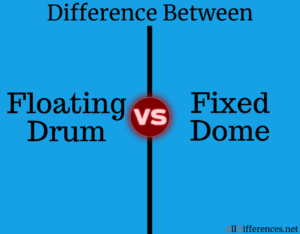Difference Between Fixed Dome and Floating Drum
Comparison Between Fixed Dome and Floating Drum
Summary:
- There are two major types of biogas designs.
-
- Floating Drum
- Fixed Dome
- The Major Difference Between Fixed Dome and Floating Drum is that. In the Fixed Dome biogas plant, an underground digester tank is used to produce biogas. The digestive tank is made of bricks and the roof of the tank is dome in shape, this dome is also made of bricks. In Floating drum biogas plant moving as old as the digestive tag this gas old is usually floated on the fermentation slurry.

Comparison Chart
| Fixed Dome | Floating Drum |
|---|---|
| Digester and gas holder, masonry or concrete structure. | Digester, masonry, Gasholder, mild steel or fiberglass. |
| It requires high masonry skills. | Low masonry or fabricating skills. |
| Low reliability due to high construction failure. | High reliability, gas holder prefabricated. |
| Variable gas pressure. | Constant gas pressure. |
| Digester could be inside the ground. | Requires space above ground for three tanks
|
| Low Cost (2 m3 = Rs.5000) | Low Cost (2 m3 = Rs.8000) |
- The floating drum is an old design with a mild-steel, Ferro-cement or fiberglass drum, which floats along a central guide frame and acts as a storage reservoir for the biogas produced.
- The fixed dome design is of Chinese origin and has a dome structure made of cement and bricks.
- It is a low-cost alternative to the floating drum, but requires high masonry skills and is prone to cracks and gas leakages.
- Family biogas plants come in different sizes depending on the availability of dung and the quantity of biogas required for cooking.
- The average size of the family is 5-6 persons, and thus biogas plant of capacity 2-4 m3 is adequate.
- The biomass requirement is estimated to be 1200 liters for a family.
